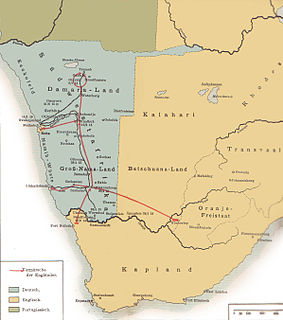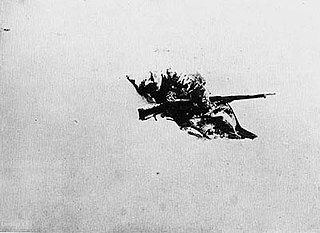
Mount Kilimanjaro is a dormant volcano in Tanzania. It has three volcanic cones: Kibo, Mawenzi and Shira. It is the highest mountain in Africa and the highest single free-standing mountain in the world: 5,895 metres (19,341 ft) above sea level and about 4,900 metres (16,100 ft) above its plateau base.

The First Battle of the Marne was a battle of the First World War fought from 6 to 12 September 1914. It resulted in an Allied victory against the German armies in the west. The battle was the culmination of the Retreat from Mons and pursuit of the Franco–British armies which followed the Battle of the Frontiers in August and reached the eastern outskirts of Paris.

The South West Africa Campaign was the conquest and occupation of German South West Africa by forces from the Union of South Africa acting on behalf of the British imperial government at the beginning of the First World War.

The Allies of World War I or Entente Powers were the coalition of countries led by France, Britain, Russia, Italy, Japan against the Central Powers of Germany, Austria-Hungary, the Ottoman Empire, and Bulgaria during the First World War (1914–1918).

The Moshi District Council is one of the seven administrative councils of the Kilimanjaro Region of Tanzania. The council is bordered to the north by the Rombo District, to the west by the Hai District, to the east by the Mwanga District and Kenya, and to the south by the Arusha Region district.

The Balkans theatre, or Balkan campaign, of World War I was fought between the Central Powers and the Allies.

The Kingdom of Romania was neutral for the first two years of World War I, entering on the side of the Allied powers from 27 August 1916 until Central Power occupation led to the Treaty of Bucharest in May 1918, before reentering the war on 10 November 1918. It had the most significant oil fields in Europe, and Germany eagerly bought its petroleum, as well as food exports.

The African Theatre of the First World War comprises campaigns in North Africa instigated by the German and Ottoman empires, local rebellions against European colonial rule and Allied campaigns against the German colonies of Kamerun, Togoland, German South West Africa and German East Africa. The campaigns were fought by German Schutztruppe, local resistance movements and forces of the British Empire, France, Italy, Belgium and Portugal.

The East African campaign in World War I was a series of battles and guerrilla actions, which started in German East Africa (GEA) and spread to portions of Portuguese Mozambique, Northern Rhodesia, British East Africa, the Uganda Protectorate, and the Belgian Congo. The campaign all but ended in German East Africa in November 1917 when the Germans entered Portuguese Mozambique and continued the campaign living off Portuguese supplies.

The Macedonian front, also known as the Salonica front, was a military theatre of World War I formed as a result of an attempt by the Allied Powers to aid Serbia, in the autumn of 1915, against the combined attack of Germany, Austria-Hungary and Bulgaria. The expedition came too late and in insufficient force to prevent the fall of Serbia, and was complicated by the internal political crisis in Greece. Eventually, a stable front was established, running from the Albanian Adriatic coast to the Struma River, pitting a multinational Allied force against the Bulgarian Army, which was at various times bolstered with smaller units from the other Central Powers. The Macedonian front remained quite stable, despite local actions, until the great Allied offensive in September 1918, which resulted in the capitulation of Bulgaria and the liberation of Serbia.

The Battle of Salaita Hill was the first large-scale engagement of the East African Campaign of the First World War to involve British, Indian, Rhodesian, and South African troops. The battle took place on February 12, 1916, as part of the three-pronged offensive into German East Africa launched by General Jan Smuts, who had been given overall command of the Allied forces in the region.

The Battle of Latema Nek was a battle of the East African Campaign in World War I.
The Battle of Kondoa Irangi was a battle of the East African Campaign of World War I.

The Battle of Ngomano or Negomano was fought between Germany and Portugal during the East African Campaign of World War I. A force of Germans and Askaris under Paul Emil von Lettow-Vorbeck had recently won a costly victory against the British at the Battle of Mahiwa, in present-day Tanzania and ran very short of food and other supplies. As a consequence, the Germans invaded Portuguese East Africa to the south, both to supply themselves with captured Portuguese materiel and escape superior British forces to the north.
The Battle of Mlali was fought during the East African Campaign of World War I. In mid-August 1916, the British General Jan Christiaan Smuts led three divisions from Kenya south into the Imperial German colony of Tanganyika in order to seize and disrupt their vital railway. The German commander Paul von Lettow-Vorbeck was informed by his scouts of the British movement and sent Captain Otto to investigate.
Gerald "Tommy" W. Thompson was a South African rugby union player. Thompson, who played club rugby for Somerset West Rugby Club, was selected for the provincial team of Western Province in 1912. He was then selected to participate in the 1912–13 South Africa rugby tour to the British Isles and France, and was capped in three tests, against Scotland, Ireland and Wales all in 1912. He played in a further 12 matches against club sides. He was considered to be one of the two best of an outstanding pack of South African forwards.

Monastir Offensive was an Allied military operation against the forces of the Central Powers during World War I, intended to break the deadlock on the Macedonian front by forcing the capitulation of Bulgaria and relieving the pressure on Romania. The offensive took the shape of a large battle and lasted for three months and ended with the capture of the town of Monastir. On an average depth of 50 kilometers, the Bulgarian First Army gave battle on six occasions and was forced to retreat five times.
Kahe is a group of wards in Moshi Rural District, Kilimanjaro Region, northeastern Tanzania. It is located 23 kilometres (14 mi) southeast of Moshi, north of the Nyumba ya Mungu Dam, and a few kilometers from the border with Kenya. There are 11 towns, including Oria Village.

The Togoland Campaign was a French and British invasion of the German colony of Togoland in West Africa, which began the West African Campaign of the First World War. German colonial forces withdrew from the capital Lomé and the coastal province to fight delaying actions on the route north to Kamina, where the Kamina Funkstation linked the government in Berlin to Togoland, the Atlantic and South America. The main British and French force from the neighbouring colonies of Gold Coast and Dahomey advanced from the coast up the road and railway, as smaller forces converged on Kamina from the north. The German defenders were able to delay the invaders for several days at the battles of Agbelouve and Chra but surrendered the colony on 26 August 1914. In 1916, Togoland was partitioned by the victors and in July 1922, British Togoland and French Togoland were established as League of Nations mandates.

The Battle of Nagyszeben was a World War I military engagement fought between the forces of the Central Powers on one side and the forces of Romania on the other side. It was the decisive engagement during the Battle of Transylvania, and also the largest, involving four armies out of the five fighting in the region: two Romanian, one German, and one Austro-Hungarian.
















